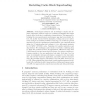Free Online Productivity Tools
i2Speak
i2Symbol
i2OCR
iTex2Img
iWeb2Print
iWeb2Shot
i2Type
iPdf2Split
iPdf2Merge
i2Bopomofo
i2Arabic
i2Style
i2Image
i2PDF
iLatex2Rtf
Sci2ools
HIPEAC
2009
Springer
2009
Springer
Revisiting Cache Block Superloading
Abstract. Technological advances and increasingly complex and dynamic application behavior argue for revisiting mechanisms that adapt logical cache block size to application characteristics. This approach to bridging the processor/memory performance gap has been studied before, but mostly via trace-driven simulation, looking only at L1 caches. Given changes in hardware/software technology, we revisit the general approach: we propose a transparent, phase-adaptive, low-complexity mechanism for L2 superloading and evaluate it on a full-system simulator for 23 SPEC CPU2000 codes. Targeting L2 benefits instruction and data fetches. We investigate cache blocks of 32-512B, confirming that no fixed size performs well for all applications: differences range from 5-49% between best and worst fixed block sizes. Our scheme obtains performance similar to the per application best static block size. In a few cases, we minimally decrease performance compared to the best static size, but best size...
| Added | 25 Jul 2010 |
| Updated | 25 Jul 2010 |
| Type | Conference |
| Year | 2009 |
| Where | HIPEAC |
| Authors | Matthew A. Watkins, Sally A. McKee, Lambert Schaelicke |
Comments (0)

